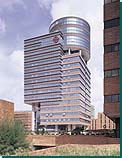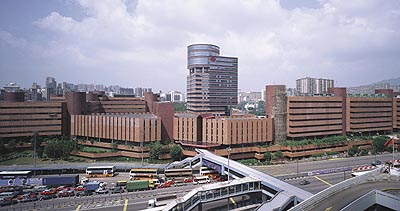| November
2001 |

 |
|
|
PolyU Phase VI Administration Building
Reaching
new heights
A greenfield site where
an architect can design a building of any shape, colour and orientation.
Wouldn't that be nice? In reality, most projects require an architect
to take at least one or two constraints into account, and the profession
is so trained to deal with them that, for many architects, they
have become nothing more than routine. Some, however, prefer to
treat such constraints differently: they see them as inspiration,
drawing upon them for ideas that would help them arrive at something
that is unique yet in harmony with its surroundings.

Phase VI of the Polytechnic
University of Hong Kong presented just this kind of challenge to
its architect, Wong Tung & Partners. As the name of the project
implies, it is part of a scheme which has been developed in phases
over time. The original campus, which was built in the early 70s,
was developed in the red brick university style of old English and
American universities, with lawns enclosed by quadrangles forming
the basic plan.
Situated in the middle
of the amorphous campus, Phase VI interfaces with practically all
existing phases of the university. And there were predetermined
conditions to work around from design through to construction. There
is the lawn lying adjacent to the 5,670 sq m site which is lined
by mature trees the client was keen to keep. There was the challenge
of producing a design that would blend in well with the strong identity
of the low-rise, red brick campus and, for the construction phase
of the project, that of maintaining circulation without endangering
the safety of staff and students.
Thanks to the relocation
of the airport to Chek Lap Kok and the subsequent lifting of height
restrictions previously imposed on Hung Hom, the architect had the
opportunity to design a taller building that would rise above the
rest of the campus and become a landmark. The client also wanted
a distinctive building as it would become the university's
headquarters, centralising
administrative and general teaching functions under one roof.
According to Wong Tung
chief architect Tracey Stoute, the design team initially considered
the idea of a curtain wall building but eventually decided to adopt
the architectural language of the existing campus and re-interpret
it to arrive at a modern look.
They took the geometry
-- the squares of the teaching and laboratory facilities and the
cylinders of the circulation cores -- and combined the existing
material -- red ceramic tiles -- with glass to come up with an 18-storey
structure consisting of four elements: a drum topping two interlocking
rectangular blocks and a semi-circular podium.
The four elements are
arranged according to their functions and express a hierarchy. Below
the podium are the general teaching classrooms while the lower floors
of the interlocking blocks contain computer laboratories for students.
Administrative offices are accommodated on the upper floors. Located
inside the upper drum are the council chambers as well as the offices
of the president and vice-president. The drum also reflects the
semi-circular senate room, which contains tiered seating for 100
people. There are also a series of "gardens in the sky"
on the 5th, 14th and 18th floors with opportunities for outdoor
dining.
The higher of the two
blocks is raised on two exposed columns in rendered reinforced concrete
that allow the offices to enjoy a panoramic view of the Kowloon
peninsula and beyond. Underneath the block is the glazed, semi-circular
podium which provides computer and exhibition facilities for students.
The clear glass reveals the vertical circulation of students within
the building, made dramatic by a steel and glass staircase that
snakes its way up from the lower podium to the third and fourth
floor computer labs.
Exposed columns are used
again, to raise the drum above the interlocking forms. Mr Stoute
said the exposed columns were a device for separating the different
elements.
"We didn't
want the drum to sit
squat on top of the towers; rather, we wanted it to hover above
them, to reinforce the impression that it is an important part of
the building, like a feature perching on its pedestals," he
explained.
As a building which rises
above its low-rise neighbourhood, it enjoys the rare advantage of
all-round views. As a consequence, there is no primary facade and
all the elevations were treated with equal attention. The external
treatment consists of alternating bands of red ceramic tiles and
silver reflective curtain wall. However, the kiln which was used
to make the tiles that clad the rest of the campus was long gone,
which led to the problem of matching new tiles to the existing ones.
It was not easy to find a tile with a matching colour. In the end,
the architect determined that an earthy tile from Inax of Japan
came closest.
Each alternate band of
material is delineated by projecting fins designed to add contrast
to otherwise flat planes, by creating depth and variation to the
elevations and thus enhancing their sculptural effect. The fins
also reinforce the horizontal articulation of the design, which
is intended to echo the horizontal spread of the campus.
The building's
all-round visibility,
while pleasant for the occupants, presented the architect with another
challenge. There is no obscure side to which plant rooms and electrical
and mechanical equipment can be shifted, so all the services were
buried within the central core. A dummy skin on the roof masks the
plant rooms located there.
As a building with multiple
users, flexibility was an important design criterion. The architect
used a central core and perimeter columns for the structure and
adopted a 9 m by 9 m grid for the internal layout. Special partitions
that can be easily dismantled without causing damage to the floor
or ceiling were procured for this project. Part of an integrated
wall and ceiling system, this partition system was used for the
first time in Hong Kong quite recently, on the Cathay Pacific headquarters.
The system, from Clestra of France, consists of ceiling panels made
up of acoustic tiles and partitions prefabricated with power and
other services built in. Telephone lines and other facilities can
be hooked up for instant "plug and play" when the partitions
are jacked into position.
With ordinary partition
systems, the sound baffles installed above the ceiling have to be
taken down and re-installed every time a partition is moved. The
Clestra system does away with this hassle as the ceiling panels
themselves act as noise baffles, ensuring the system conforms with
the client's
noise insulation requirements. Although the layout is standardised,
the system's
flexibility allows it to serve the specific needs of the departments
occupying different floors of the building.
Visible from the busy
transport network surrounding the campus, the 25,200 sq m building
now stands as a landmark and focal point not just for the university,
but the entire Hung Hom/Tsim Sha Tsui area.
Polytechnic University
of Hong Kong
client
PolyU Estates Department
project manager
Wong Tung & Partners
architect
Hong Kong Construction
contractor
Mott Connell
structural engineer
Mott Connell
M&E engineer
Arup Facade Engineering
facade engineer
Davis Langdon & Seah
quantity surveyor
|

